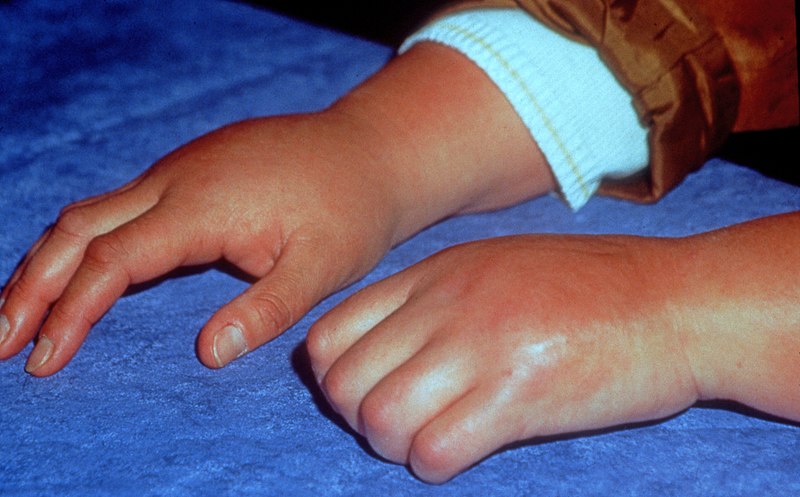https://images.hive.blog/DQmUnNB8nC8yyhXkK1ZmjJg7jHNyacNaJDwdDmzBYCFaNkC/800px-CRPS_002ms5.jpg
[Complex regional pain syndrome (CRPS)](https://www.google.com/url?sa=t&source=web&rct=j&url=https://www.mayoclinic.org/diseases-conditions/crps-complex-regional-pain-syndrome/symptoms-causes/syc-20371151&ved=2ahUKEwjTzNvY_b3rAhURmVwKHXNgB-cQFjANegQIChAB&usg=AOvVaw10PcojsIDf3B4gnoMSjaIl) is a form of chronic pain that usually affects an arm(hands) or a leg. CRPS commonly develops after an injury, a surgery, a stroke or a heart attack. The pain goes beyond the severity of the initial injury. CRPS is not common, and its cause isn't clearly understood. Treatment is most effective when started early. In such cases, improvement and even lessening of pain are possible. **SYMPTOMS** Signs and symptoms of CRPS include: * Incessant burning or throbbing pain, usually in the arm and leg. * Sensitivity to touch or cold(or even if wind blows). * Swelling of the /affected painful area.

[Swollen hand of a CRPS patient; By Author:](https://upload.wikimedia.org/wikipedia/commons/9/9e/CRPS_002ms5.jpg) Sourced from Wikimedia Under [Creative Commons](https://en.m.wikipedia.org/wiki/Creative_Commons)
* Changes in skin temperature. * Changes in skin color(complexion). * Changes in skin texture, which may become tender, thin or shiny in the painful/affected area. * Changes in hair and nail growth. * Joint stiffness, swelling and damage. * Muscle spasms, tremors, weakness and loss caused by injury or lack of use(Atrophy). * Decreased ability to move the affected body part due to pain arising from it. Symptoms may change over time and vary from person to person based on patient's body system. Pain, swelling, redness, noticeable changes in temperature and hypersensitivity usually occur first in most patients with CRPS. Over time, the affected/painful limb can become cold and pale. It may undergo skin and nail changes as well as atrophy. Once these changes occur, the condition is usually irreversible. CRPS occasionally may spread from its source to elsewhere in the patient's body, such as the opposite limb. In some people, symptoms of CRPS go away on their own without medical interference. In others, signs and symptoms may persist for months to years. Treatment is most likely effective when started early. **CAUSES** The cause of CRPS isn't completely understood. It's thought to be caused by an injury to or an abnormality of the peripheral and central nervous systems. CRPS typically occurs as a result an injury. CRPS occurs in two types, with similar symptoms, but different causes: 1.) **Type 1**-This is known as Reflex Sympathetic Dystrophy (RSD), this type occurs after an illness or injury that didn't directly damage the nerves in your affected limb. 2.) **Type 2**-Also referred to as causalgia, this type has symptoms similar to those of type 1 but type 2 CRPS occurs after a distinct nerve injury. Many cases of CRPS occur after a forceful trauma to an arm or a leg, this can include a crushing injury or a fracture. Other traumas such as surgery, heart attacks, infections and sprained ankles can also lead to CRPS. It's not well understood why these injuries can trigger CRPS. Of course, not everyone who has such an injury will go on to develop CRPS. It might be due to a dysfunctional interaction between your central nervous system and peripheral nervous system and inappropriate inflammatory responses. **COMPLICATIONS** If CRPS isn't diagnosed and treated at early stage, the disease may progress to more disabling symptoms. These may include: 1.) **Tissue wasting (atrophy)**:- The patient's skin, bones and muscles may begin to deteriorate and weaken if you avoid or have trouble moving an arm or a leg because of pain or stiffness. 2.) **Muscle tightening (contracture)**:- The patient also may experience tightening of your muscles. This may lead to a condition in which the patient's hand and fingers or foot and toes contract into a fixed position. **PREVENTION** These steps might help you reduce the risk of developing CRPS: 1.) **Taking vitamin C after a wrist fracture**:- Studies have shown that people who take a high dose of vitamin C after a wrist fracture may have a lower risk of contacting CRPS compared with those who didn't take vitamin C. 2.) **Early mobilization after a stroke**:- Research suggests that people who get out of bed in the morning and walk around soon after a stroke (early mobilization) reduce their risk of developing CRPS. ### CONCLUSION CRPS is the opposite of CIPA which I posted about two days ago on [my blog](https://hive.blog/hive-196387/@sirpee6/an-unnoticeable-illness-that-kills-congenital-insensitivity-to-pain-with-anhidrosis-cipa). CIPA patients doesn't feel pain at all, no matter how hurt the action pulled against their body while CRPS patients feel pain even if the wind blew towards their direction. Imagine how the pain of a CRPS patient would be. ### It is of utmost importance for us to stay healthy and safe at all times. Thanks for reading ! ### Reference [Complex Regional Pain Syndrome- Symptoms and causes](https://www.google.com/url?sa=t&source=web&rct=j&url=https://www.mayoclinic.org/diseases-conditions/crps-complex-regional-pain-syndrome/symptoms-causes/syc-20371151&ved=2ahUKEwjTzNvY_b3rAhURmVwKHXNgB-cQFjANegQIChAB&usg=AOvVaw10PcojsIDf3B4gnoMSjaIl)


Originally posted here: https://hive.blog/hive-196387/@sirpee6/complex-regional-pain-syndrome-crps


No comments:
Post a Comment